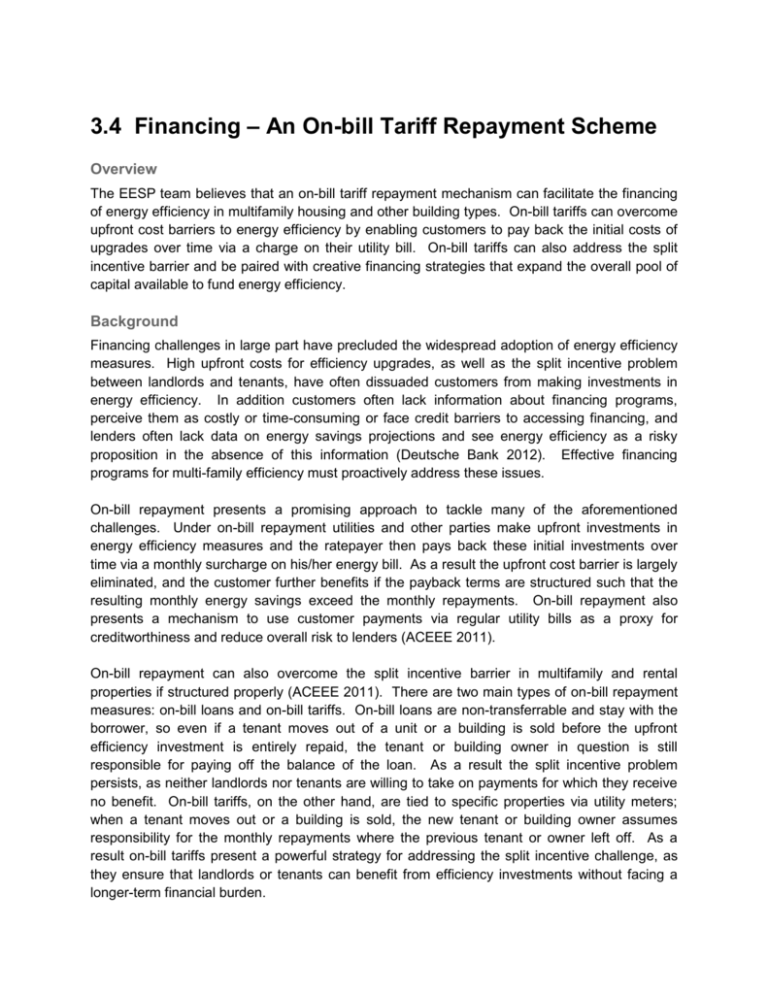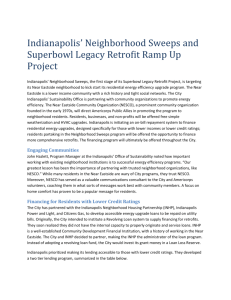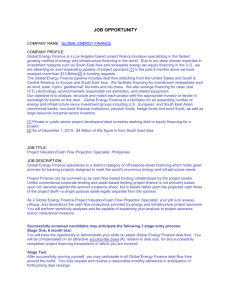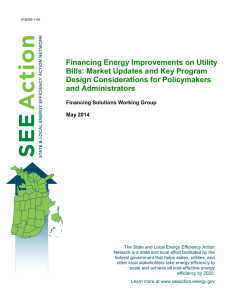ToR - on-bill tariffs
advertisement

3.4 Financing – An On-bill Tariff Repayment Scheme Overview The EESP team believes that an on-bill tariff repayment mechanism can facilitate the financing of energy efficiency in multifamily housing and other building types. On-bill tariffs can overcome upfront cost barriers to energy efficiency by enabling customers to pay back the initial costs of upgrades over time via a charge on their utility bill. On-bill tariffs can also address the split incentive barrier and be paired with creative financing strategies that expand the overall pool of capital available to fund energy efficiency. Background Financing challenges in large part have precluded the widespread adoption of energy efficiency measures. High upfront costs for efficiency upgrades, as well as the split incentive problem between landlords and tenants, have often dissuaded customers from making investments in energy efficiency. In addition customers often lack information about financing programs, perceive them as costly or time-consuming or face credit barriers to accessing financing, and lenders often lack data on energy savings projections and see energy efficiency as a risky proposition in the absence of this information (Deutsche Bank 2012). Effective financing programs for multi-family efficiency must proactively address these issues. On-bill repayment presents a promising approach to tackle many of the aforementioned challenges. Under on-bill repayment utilities and other parties make upfront investments in energy efficiency measures and the ratepayer then pays back these initial investments over time via a monthly surcharge on his/her energy bill. As a result the upfront cost barrier is largely eliminated, and the customer further benefits if the payback terms are structured such that the resulting monthly energy savings exceed the monthly repayments. On-bill repayment also presents a mechanism to use customer payments via regular utility bills as a proxy for creditworthiness and reduce overall risk to lenders (ACEEE 2011). On-bill repayment can also overcome the split incentive barrier in multifamily and rental properties if structured properly (ACEEE 2011). There are two main types of on-bill repayment measures: on-bill loans and on-bill tariffs. On-bill loans are non-transferrable and stay with the borrower, so even if a tenant moves out of a unit or a building is sold before the upfront efficiency investment is entirely repaid, the tenant or building owner in question is still responsible for paying off the balance of the loan. As a result the split incentive problem persists, as neither landlords nor tenants are willing to take on payments for which they receive no benefit. On-bill tariffs, on the other hand, are tied to specific properties via utility meters; when a tenant moves out or a building is sold, the new tenant or building owner assumes responsibility for the monthly repayments where the previous tenant or owner left off. As a result on-bill tariffs present a powerful strategy for addressing the split incentive challenge, as they ensure that landlords or tenants can benefit from efficiency investments without facing a longer-term financial burden. Program Recommendations While on-bill tariff repayment presents an attractive solution to many energy efficiency financing barriers, its implementation comes with its own set of challenges. Perhaps most notably, on-bill repayment can often require complicated modifications to utility billing systems (ACEEE 2011), and NSTAR in the past has declined to implement on-bill repayment in Cambridge for precisely this reason (Cascadia Consulting Group 2008). However given the City of Cambridge’s and NSTAR’s current mutual interest in developing a multifamily efficiency pilot that can be a model for long-term programmatic change, we believe the time is now to revisit these issues and think critically about strategies to implement on-bill tariffs in the multifamily sector. Financing sources and structures are also critical considerations in ensuring the success of onbill repayment programs. Relying exclusively on utility ratepayer funds precludes energy efficiency programs from achieving scale and can also put utilities in the position of acting as financiers – a role beyond their traditional areas of expertise that can raise overhead costs and expose them to liability under consumer lending laws (EDF 2011). To address these issues, effective programs must leverage outside sources of capital and enable utilities to act as capital intermediaries rather than fund managers. Additional sources of capital include debt (e.g. from Community Development Financial Institutions [CDFIs] and banks), equity (e.g. from federal New Market Tax Credits and mission-driven investors) and foundation and government grants. These sources of capital along with existing utility ratepayer funds can be pooled into a broader energy efficiency fund, which can be managed by a non-utility partner with relevant financial expertise. The fund can then directly finance energy efficiency upgrades and recoup these upfront payments via the monthly on-bill tariff. The example of MPower, a new energy efficiency program in Oregon that uses on-bill tariffs to target the multifamily affordable housing sector, is instructive with respect to the financing issues outlined above. The program currently draws 30 percent of its funding from utility incentives, 20 percent from U.S. Department of Housing and Urban Development (HUD) grants and 50 percent from CDFI debt; in the long term the program seeks to structurally supplant the HUD grants with equity from New Market Tax Credits to ensure sustained financing (Warner 2012). The program fund is managed by the non-profit Network for Oregon Affordable Housing, and organizations such as the CDFI Craft3, the Energy Trust of Oregon and Enterprise Community Partners provide additional support in terms of funding, technical assistance and service delivery (Warner and Daniel 2012). The MPower model highlights the need for strong partnerships and a deliberate stakeholder engagement strategy to ensure sustainable program design and financing, and we encourage the City of Cambridge to play a leadership role in convening relevant financial players who can support and manage an energy efficiency fund. In conjunction with on-bill repayment via a tariff mechanism, Cambridge and NSTAR can also consider several other strategies to address financial barriers to energy efficiency. These include providing energy data before or at the point of loan application to enable lenders to incorporate cost and savings projections into their underwriting (Deutsche Bank 2012), using financing products to bundle together multiple energy efficiency measures to spur deeper retrofits (ACEEE 2011), and using public benefit and utility funds to provide credit enhancements or buy down interest rates (ACEEE 2011). Employing a portfolio of these approaches will ensure that both customers and lenders can access important information, reduce their overall financial risks and have stronger incentives for participation. Potential Practicum Work Items ● ● Develop guidance for establishing and managing a Fund through which on-bill repayment could be made. Pro-forma, suggesting what IRR of measures could be included in projects, given different terms of financing. References American Council for an Energy Efficient Economy (ACEEE). (2011). “On-Bill Financing for Energy Efficiency Improvements: A Review of Current Program Challenges, Opportunities and Best Practices.” Cascadia Consulting Group. (2008). “On-Bill Financing.” October 7, 2008. Deutsche Bank. (2012). “The Benefits of Energy Efficiency in Multifamily Affordable Housing.” January 2012. Environmental Defense Fund (EDF). (2011). “On-Bill Repayment: Unlocking the Energy Efficiency Puzzle in California.” Warner, John. (2012). Personal communication. November 28, 2012. Warner, John and Kat Daniel. (2012). “MPower Oregon: Multifamily Energy Efficiency.” Presentation to the ACEEE Finance Forum, May 7, 2012.







